Here in Weymouth and Portland we are blessed with a bevvy of beautiful parks and gardens, they all embrace their own special identity.
Unbeknown to many visiting Weymouth, one hidden garden holds a fascinating history, that of fighting men and fearsome artillery. It stands secreted away right next to the harbour, tucked away beneath a solid green canopy.
Sitting up on the tree covered Nothe peninsular are Weymouth’s well-loved ‘ragamuffin’ gardens.
Don’t get me wrong…I really do mean that ‘ragamuffin’ in the nicest sense possible.
After all, I spent an awful lot of my childhood charging around them with my friends and still love visiting them with my grandchildren.
They always had that slightly wild, unkempt feel to them, wonky paths, foot-worn steps, steep slippery slopes, but that only made them so much more appealing.
Where better to play a boisterous game of hide and seek or chase me charlie? (Thankfully, that still holds true for todays youngsters)
Going back centuries, the Nothe peninsular had always been viewed as an open community space as far as the town and its residents were concerned.
Early 19th century local pilots watched out for incoming vessels from here, spy glass in hand, sat snug inside their makeshift cabin, a rickety upturned wooden hull.

Victorian coastguards set their sights firmly on the far horizon, guarding our shores from anyone who was less than welcome, possible smugglers or would-be invaders, all came under their steady, watchful gaze.
Wealthy tourists of the day, would meander upon it’s windswept top, keen to inhale that health giving breeze.
Artists came and perched, paints and easels at hand, ready to capture Weymouth’s Bay of Naples beauty.
Then during the 1850’s and 1860’s this land was requisitioned by the War Office and despite a series of futile protests from the town’s corporation, the Nothe became a full blown military site
With Napoleon supposedly rattling his sabres on the not too far off shores, it was deemed sensible to start building a series of coastal fortifications…just in case.
By the 1870’s all construction work was completed, the Nothe Fort now stood there proud and strong at the tip of the ridge.
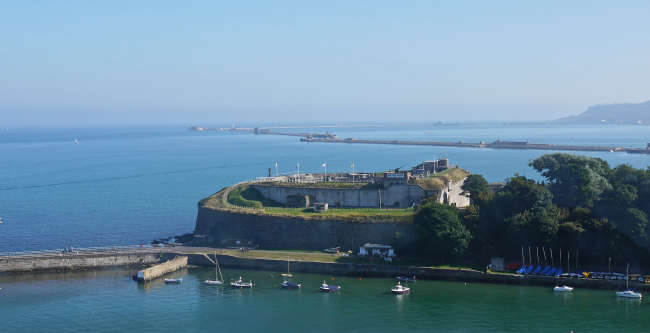
Weymouth’s corporation, keen to reclaim the use of this popular piece of land again, approached Colonel Belfield, CRE (Commander Royal Engineers) the man charged with constructing the Weymouth and Portland coastal defences. (Sat to the right of this dashing trio.)

Once all negotiations were completed between the War Office and Weymouth Corporation, for a peppercorn rent of £1 a year, Weymouth inhabitants and their lucrative tourists could once more enjoy the stunning views from atop its ridge.

Eager to make a start, paths was laid out and seats put in place…but it was still very much a military site, consequently, certain restrictions were made on those earlier plantings.
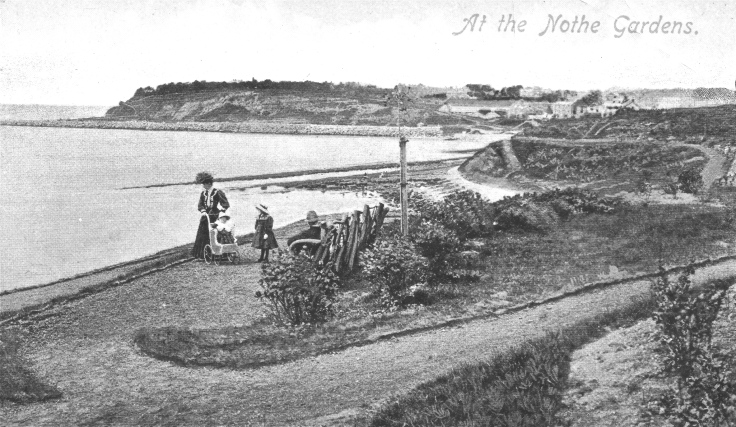
No trees or shrubs should be placed that obstructed the firing line of any of the great guns that now dotted this headland.
The top was to be kept open and clear, for this was to be used for visiting troops and their tented camps, of which there were many.
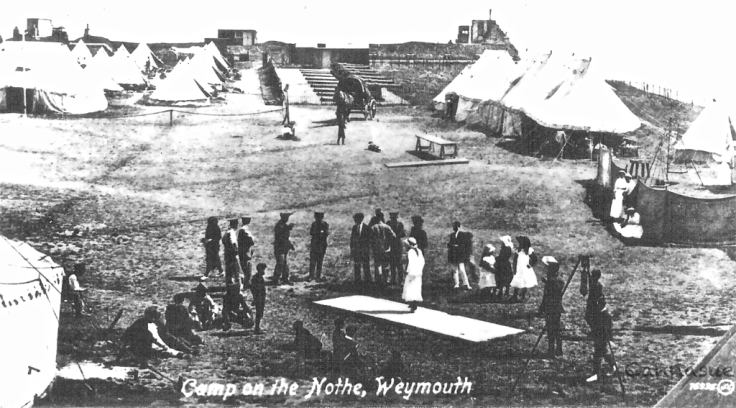
No military camp exclusion zones existed then, no great barbed wire fences or guarded gates separated soldiers and their territory from civilians. the two fractions mingled quite freely.
Indeed locals would frequently find their way up the slope to partake in some of the soldiers benefits, using their smoking and reading tent to catch up on world events, listen to the bandsmen rehearsing for their next performance.
There was even a sad case of a family of five starving young children who went from tent to tent begging the soldiers for scraps of food. (Their parents were reported and taken to court.)
The gardens became a place for one and all to enjoy, from smartly turned out soldiers to delicate ladies and their twirling parasols.
Over the following years, folks continued to enjoy its blossoming gardens, as more paths were laid, rockeries built, additional trees and shrubs added.
True to Victorian pleasures, a bandstand was added, where local and visiting musicians would play, many of them being resident or visiting military bands.
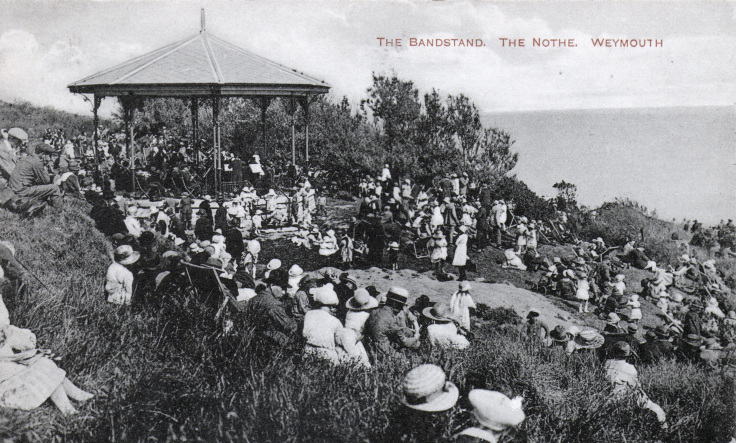
The sweet notes of their tunes floating out over the bay’s waters would draw people up the slopes from far and wide.
The steep harbourside cliff face eventually sported a series of narrow, criss-crossing footpaths, slopes and steps that as a child were great fun to hare along…
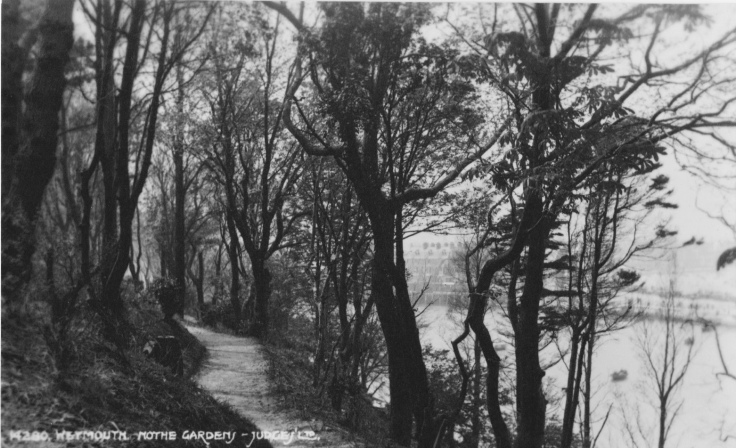
…that is until you came a cropper and ended up tumbling down the muddy slopes only to face your parent’s wrath when you crept in the door at the end of the day, clothes torn, hands and knees scraped and caked in head to toe with mud.
But then, that was simply childhood in those days.
The gardens were still a bustling military site at the start of the 20th century.
Numerous postcards captured fleeting moments of those long gone military men, such as the one below depicting soldiers of the Royal Garrison Artillery Volunteers stood to attention on a Sunday morning, ready for inspection before they set off to that morning’s church parade.

Spectators were still free to wander up to watch such going-on’s.
Come WWII and the vital defences of our shores brought the Nothe Fort and its gardens into military action once more.
A heavy anti-aircraft battery was set in place on the top near the fort, their guns manned by men and women of the Artillery division. A set of temporary huts housed those troops serving their time on this windswept ridge. (These were also used afterwards to house many of the Weymouth families who lost their homes during bombing raids.)
A powerful searchlight was set atop the sea facing wall, its blinding beams sweeping across the bay and the skies for any approaching enemy.
Sadly, a massive landslide in the 1988 saw the tall sea wall and its searchlight housing swept downwards and into the sea.
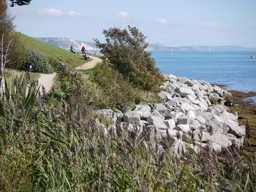
A line of massive Portland stone blocks now hug the shoreline, attempting to retain this notoriously unstable ground in its place. (Unstable ground was something that the Victorian Royal Engineers also had to contend with while constructing the Nothe Fort.)
These beautiful gardens still remain very popular with many locals, their spacious open top no longer houses the heavy canvas shelters of soldiers but picnic rugs and BBQ’s.
The air is nowadays more likely to be filled with the sweet laughter of excited children as they race around and play than that of belligerent drill sergeants with their sharp tongued retorts.
But the Nothe also holds another hidden delight…The Peace Gardens, which once used to be the Friends Burial Ground.
Their fascinating story will be for another day.
This year, Weymouth Civic Society has chosen to celebrate Weymouth and Portland’s wonderful community spaces and the work of those who tend them and support them. Saturday 17th June has been set as a day for showing off our gardens and parks heritage to one and all.
Maybe you’ll discover amazing spaces you never knew existed, tiny gardens tucked away inside derelict buildings, immaculate parks that house Tudor castles.
Free maps will be available, detailing all these community spaces and setting out routes that people can take to tour them.
A series of events have been planned in many of our parks and gardens for that day, from live music to Teddy Bear Picnics, trying your hand at art and helping wildlife.
Check out our Face Book page to keep an eye on what’s happening in a park near you.
Read on to discover more about the Weymouth Civic Society and their aims for the 17th June to show off our local parks and gardens.
‘In 2016 Weymouth Civic Society awarded Weymouth and Portland Borough Council’s Parks and Open Space Service a ‘Letter of Appreciation’ to recognise the planting and regular maintenance of the gardens in the Borough and the Esplanade flowers beds, despite the severely limited budget available and acknowledged that many of the Borough’s gardens are supported by enthusiastic ‘Friends’ groups.
Following this, Weymouth Civic Society decided this year to celebrate National Civic Day on Saturday 17th June.
Civic Day is initiated annually by the ‘Civic Voice’ as a national celebration of civic pride when communities across the country hold events to celebrate their area, last year there were over 150 Civic Day events.
WPBC Parks, Gardens and Open Spaces Service, all of the Friends groups of the public gardens and the Mayor elect for 2017-8 supported this initiative which is now registered with the Civic Voice (https://www.civicvoice.org.uk).
The organising committee of the Civic Society and the Friends groups of the gardens are producing a map, that will be freely available to the public through a variety of outlets prior to the day, showing the location of all the gardens with suggested routes that locals and visitors could take on Saturday 17th June to visit some or all of the gardens.
Each garden that has a Friends group has agreed to either to hold an event in their garden or have a presence in the garden to tell visitors about the garden and what their Friends group does.
Those gardens without Friends groups would appear as waypoints on the map.’
https://www.nothegardens.org.uk/exploring.php





